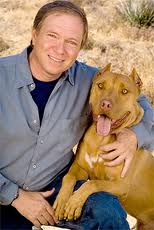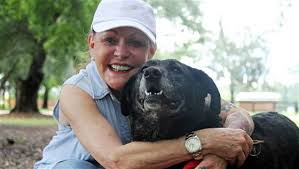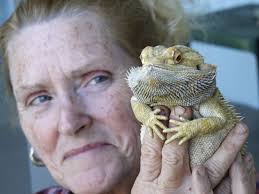One Giant Leap For Pet Kind!
Stephen Eisele, Celestis Pets
 Celestis Pet will shoot your pet's cremains into deep space, or to the moon, or even into orbit around the earth. The rocket and space technology company has been launching satellites and human remains for over a decade. Now, they want a piece of the 58 BILLION dollar pet industry. Top Dog Stephen Eisele explains what you get for your $1,000. It's pretty impressive!
Celestis Pet will shoot your pet's cremains into deep space, or to the moon, or even into orbit around the earth. The rocket and space technology company has been launching satellites and human remains for over a decade. Now, they want a piece of the 58 BILLION dollar pet industry. Top Dog Stephen Eisele explains what you get for your $1,000. It's pretty impressive!
Celestis Pets is actually an airspace company that has launched satellites in the past, which contributed to NASA projects. For many years, they have what they call a memorial space flight service for humans. This provides the opportunity to send loved ones on a final memorial trip to outer space. So why pets?
They received many inquiries from their past customers, as well as from people around the world, who said, "What about our pet. Can we honor our pet in the same way?" That is how Celestis Pets was launched.
They consider that sending that your pet into space is like lighting the largest candle n honor of your pet, which is unforgettable. You are able to watch the launch that holds your pet, and in some cases, you are actually able to track the craft so you can know where your pet is at all times.
Celestis Pets offers four basic services:
'
One service is the Earth Rise, which is a trip to space and back. You will be able to get the remains from the craft after the flight as a keepsake.
Another service is Earth Orbit, which means it orbits the Earth sometimes for thousands of years, which is a forever trip.
 There is also the Luna Service, which is actually a trip to the moon. This allows your pet to howl from the moon!
There is also the Luna Service, which is actually a trip to the moon. This allows your pet to howl from the moon!
Lastly there is the Voyager Service, which can go anywhere.
Prices start at $995, where you can send your deceased pet up for an Earthrise. A lap or two around the planet will run you $4,995. Lunar and deep space services are also available, and as you'd expect they're a whole lot pricier. Celestis starts those upper tiers off at $12,500.
All the remains, whether human or pet, are integrated into an existing spacecraft. This means that they are a part of the spacecraft and not scattered into space.
Does this create more space debris that we need to worry about? Stephen assures us that it doesn't, because they are all integrated with existing spacecraft.
In a neat way, you are actually contributing to the exploration of outer space and contributing to funding of existing space crafts and science experiments and experiments that students put up into space. It's a great way to give back as well as to memorialize.
Celestis Pets have been sending humans into space for a while now, but have yet to send their first pet. For humans, they have been sending as many as 300 individuals up at one time. However, they are more like symbolic remains in that it is not the complete ashes, it is only between 1 and 7 grams, which is what they will also do with pet remains.
While most memorial services draw a lot of tears, Stephen tells us that at the launchings, it is one of the few memorials where people are high-fiving and cheering! It is a happy thing to know that no matter where you are, you can look up to the stars and your loved one will be there!
Visit Website
Speak Your Dog's Language
Justin Silver and Dave Donnenfeld, The Language Of Dogs
 TV Dog Trainer Justin Silver is back with his really funny friend, Dave Donnenfeld. "Together they're 'righting' canine 'wrongs' wherever bad dogs and bad guardians need them in their book, which is the Rosetta Stone of Doglish," says Animal Radio host Hal Abrams.
TV Dog Trainer Justin Silver is back with his really funny friend, Dave Donnenfeld. "Together they're 'righting' canine 'wrongs' wherever bad dogs and bad guardians need them in their book, which is the Rosetta Stone of Doglish," says Animal Radio host Hal Abrams.
Justin Silver and Dave Donnenfeld have been working together for over 17 years. So when the opportunity arose to write this book, Justin passed on a ghost writer as Dave is a prolific writer and is great at interpreting what Justin does with the animals, as well as working with the psychology of the people.
The first thing they wanted to do in the book was to debunk the idea that dogs are limited. If you think about dogs from an evolutionary standpoint, these guys have managed to make a living off of humans, while doing very little.
Dogs are entirely dependent upon us, and they get petted and fed for essentially being cute. They are also very bright and a lot more adept at picking up cues then even primates.
 Justin and Dave wanted to demonstrate in the book that you should listen with your eyes and look ay your dog with a pair of fresh eyes. It doesn't matter if you are dealing with a puppy or a 7-year-old dog that seems set in his ways. They are all capable of learning and essentially learning in the same way.
Justin and Dave wanted to demonstrate in the book that you should listen with your eyes and look ay your dog with a pair of fresh eyes. It doesn't matter if you are dealing with a puppy or a 7-year-old dog that seems set in his ways. They are all capable of learning and essentially learning in the same way.
Dave tells us that he and Justin often come across the same scenario when dealing with trainers. They basically want to bring in their own set of tools and what they do in order to teach dogs. But, owners know their dogs better than anyone. They know their cues, they know their quirks and they know their foibles. This makes the pet owner pick up a lot more than they realize. But the approach that Dave and Justin have is to basically teach the owner how to teach their dog.
Learning how to "speak dog" may sound like an unusual way to embark on training a dog, but that's how Justin Silver has achieved his remarkable successes and that's exactly what he wants to teach you as well. Whether you merely want to understand your dog better, or there's a troublesome behavior you've been unable to fix, Justin encourages you to move past stereotypes such as "hyper" or "aggressive" and listen to what your dog is trying to tell you.
Justin's approach is based on a key concept. Don't tell your dog what you don't want. Instead, tell your dog what you do want. To help you implement this technique, he shows how easy it is to teach your dog some familiar positive behaviors—such as "sit," "come," and "stay" — that will help you and your dog learn to live happily together.
Visit Website
"HERO PEOPLE OF THE WEEK" - Leo Grillo, D.E.L.T.A.
 When his agent asked, "Do you want to act or do you want to save animals," after he kept missing auditions, Leo Grillo chose to dedicate his life to the creatures. That makes Leo Grillo, the founder of DELTA rescue, our Hero Person. He has over 1,500 animals on 115 acres. He doesn't adopt-out any of these animals because his statistics say owners keep their animals only 2.5 year on average.
When his agent asked, "Do you want to act or do you want to save animals," after he kept missing auditions, Leo Grillo chose to dedicate his life to the creatures. That makes Leo Grillo, the founder of DELTA rescue, our Hero Person. He has over 1,500 animals on 115 acres. He doesn't adopt-out any of these animals because his statistics say owners keep their animals only 2.5 year on average.
Founder and Chief Rescuer Leo Grillo celebrated the 40th Anniversary of Delta Rescue, the largest no-kill, care for life animal sanctuary for rescued animals in the world. The sanctuary is located in Acton, California on over 115 acres and houses over 1500 dogs and cats, plus a few dozen horses, pigs and goats.
Years ago, Leo was a movie actor living with three cats in Hollywood. His career was just starting when he found some dogs in the woods, actually more like a few dozen. It was no easy task taking care of and feeding all of the dogs, all while trying to work as an actor as well. He then got a call from his agent who said you are going to have to choose, because you keep missing auditions, it's your dogs or your career. Leo chose the dogs.
 Unfortunately at that time, Leo was living in the City of Glendale, which had a two-dog limit. By 1983, Leo was feeding over 150 dogs in the forest, not to mention 29 dogs and 12 cats in his house. Clearly he needed his own shelter. In October after the City of Glendale cited him for having too many animals, there was a story in the newspaper about the case. Sympathetic readers sent $20,000, which Leo managed to use as a down payment on a 50-year-old kennel he purchased in El Monte, CA. It was a disaster and condemned, but he cleaned up the shelter all by himself and this humble shelter became home to 250 rescued dogs and cats. This was Leo's first shelter, where he did adopt the animals out.
Unfortunately at that time, Leo was living in the City of Glendale, which had a two-dog limit. By 1983, Leo was feeding over 150 dogs in the forest, not to mention 29 dogs and 12 cats in his house. Clearly he needed his own shelter. In October after the City of Glendale cited him for having too many animals, there was a story in the newspaper about the case. Sympathetic readers sent $20,000, which Leo managed to use as a down payment on a 50-year-old kennel he purchased in El Monte, CA. It was a disaster and condemned, but he cleaned up the shelter all by himself and this humble shelter became home to 250 rescued dogs and cats. This was Leo's first shelter, where he did adopt the animals out.
Leo states that people abandon their pets all kinds of ways and one of the ways is to dump them at picnic areas or campgrounds. Then from those, you have dogs and cats that are born in the wild. These animals are not feral, they just happen to be born in the wild. They can grow up to be loving animals and they all have souls.
All animals in Leo's sanctuary are abandoned. They have all been dealt a bad card. He doesn't adopt them out, because he's not going to take a chance of them ever having to go through it again
A study was done years ago before the recession, where Leo states the statistics showed that people only keep their pets on an average of 2.5 years in America, and that since the recession, it has only gotten worse.
Most rescuers take dogs from shelters and adopt them out. The reason Leo doesn't do this is because he spends a lot of time and emotion to get them to safety and he is not going to let them go to a home only to have them given up again in a few years.
Leo wants everyone to look at him and see what he's done for these 1,500 animals. He feels that everyone can do their part and take care of a few.
Visit Website
Dogs Get The Flu Too - Canine Influenza - Dr. Debbie
 Can you give your dog the flu, or catch it from him? No way. But dogs can become infected with their own strain of canine influenza. With much attention on the tough human flu season, it's a good time to talk about the differences, and similarities, between human and canine influenza.
Can you give your dog the flu, or catch it from him? No way. But dogs can become infected with their own strain of canine influenza. With much attention on the tough human flu season, it's a good time to talk about the differences, and similarities, between human and canine influenza.
What is Dog Flu?
Canine Influenza, also known as H3N8, is a relatively new dog virus identified in 2004.The disease mutated from a strain of the equine influenza virus and was first detected in racing greyhounds. Canine influenza has migrated across the country and infections have been detected in 39 states, with heavy reports in recent years in New York, New Jersey, Florida and Colorado. However, some areas of the country have yet to report a single case of canine influenza.
Although the human flu peaks in winter seasons, canine influenza doesn't show seasonality; rather dogs can acquire canine influenza all year round.
The Illness
A dog sick with canine influenza develops respiratory infection signs similar to kennel cough that last three to four weeks. Symptoms include coughing, gagging, sneezing, runny nose and high fevers up to 104-106 degrees. Normal dog temperature ranges 101-102 degrees Fahrenheit.
Most dogs infected with canine influenza will get sick and recover. But like the human flu, fatalities can occur. Approximately 5-percent of canine influenza infected dogs may die, usually to secondary pneumonia. Older pets, pups, or those with chronic illness are more likely to develop pneumonia than the average healthy dog.
There isn't a specific treatment for dogs infected with canine influenza, but most dogs recover with supportive care including good nutrition, rest and maintaining adequate hydration. Severely ill pets with secondary bacterial pneumonia may be hospitalized and treated with IV fluids and antibiotics.
 Dog Flu Transmission
Dog Flu Transmission
Dog flu is similar to human flu in that it is spread by aerosol transmission as well as through contact with contaminated items. Since dogs don't cover their cough or sneezes, the virus is easily carried through respiratory droplets to other dogs and items in the immediate area. Any place that canines frequent, or spend time around, can become contaminated by infected dogs - that includes water bowls, surfaces and even human hands.
What do you do if you notice your dog's play pal is coughing, sneezing and has a runny nose? Separate your dog immediately and closely monitor your dog for symptoms for 7 days - the time it takes for symptoms to appear after exposure to the virus. If symptoms develop, call your veterinarian.
Pass that timeline and you are probably fine. But don't forget that 10 to 20-percent of infected dogs will shed the virus, but never show any symptoms of illness. These apparently healthy carriers can go on and spread the infection to other dogs without ever becoming ill.
Vaccination and Prevention Steps
A vaccine, produced by Merck, is available through veterinarians for canine influenza. But just like the human flu vaccine, it doesn't guarantee your dog CAN'T get sick. However the vaccine is helpful in decreasing the severity of infection and decreasing the spread of virus.
Vaccination for canine influenza isn't recommended for every dog at this time. Lifestyle and geographic location influence an individual dog's risk of acquiring canine influenza. Dogs that frequent high-density dog areas are at increased risk of canine influenza and are candidates for vaccination. So if your dog goes to areas like the dog park, trainer, groomer or boarding facility, ask your veterinarian if vaccination is a good idea.
Don't think you have to keep your dog locked in the house forever to hide from canine influenza. For most dogs, the risk of contracting canine influenza is quite small. Good sense and preventative steps are useful to avoid dog illness. These include quarantining new or sick dogs, using good hygiene through disinfection and hand washing and avoiding unnecessary contact with suspected infected dogs, especially if your dog is young, old, or has a compromised immune system.
What Should Pet Owners Do?
Flu awareness and preparedness makes good sense - for both people and pets. But remember that there are other causes of canine respiratory disease. So just because you hear a cough doesn't mean your dog has the flu. Ask your veterinarian about your pet's individualized risks for acquiring canine influenza.
Featured veterinarian known as "Dr. Debbie" on national pet radio program, Animal Radio. Ebook author of "Yorkshire Terriers: How to Be Your Dog's Best Friend"; "Pugs: How to Be Your Dog's Best Friend"; "Mini Schnauzers: How to Be Your Dog's Best Friend"; and "Shih Tzu: How to Be Your Dog's Best Friend." Dr. Debbie's books.
Visit Website
Animal Radio News with Tammy Trujillo
 Dumped Dog Hits Jackpot
Dumped Dog Hits Jackpot
You might have heard about a dog known as Mama, a senior black Labrador Retriever who had trouble walking, but who went on a 30-mile trek back to the family that had dumped her at the shelter when she couldn't adjust to a new puppy in the family. She was adopted, but left that family to fine her old one, who took her right back to the shelter. Well, the story made the papers and it caught the eye of Wrigley Chewing Gum heiress Helen Rich. She was vacationing in Hawaii at the time, but jumped on the chance to help Mama out. She sent one of her assistants on a private jet to get Mama and take her to her huge farm and mansion in Florida that is already loaded with rescued and retired animals.
Find Your Lost Dog By Facial Recognition App
There are many apps for finding lost pets, but a new one being tested out in San Diego has gone a step further, it's using facial recognition software. It's called FindingRover.com and it matches eight distinctive facial markers on dogs with images uploaded by people searching for lost pets. Eyes and noses are important areas to help tell dogs apart; especially the eye size and how the eyes are positioned near the snout. Every dog that comes into any of San Diego's three shelters is entered into the database. And using it is free for anyone who has lost their dog. The technology powering Finding Rover was built by Steven Callahan and John Schreiner of the University of Utah's software development center.
 Woman Does CPR on Bearded Dragon
Woman Does CPR on Bearded Dragon
When you love your pet, you love your pet, no matter what breed or species he or she is. That explains the actions of a woman in Salem, Oregon. Sherrie Dolezal runs a bearded dragon rescue and came home the other day to see one of lizards named Del Sol floating unconscious in the pool. She got him out, started pounding on his back and doing chest compressions. She finally started CPR and he started breathing again. Del Sol and Sherrie are now doing just fine.
Raw Pet Food Warning
With all the pet food recalls, some people are now turning to feeding their pets raw food. But the FDA is out with a warning on that. Raw food increases the risk of food poisoning for you and your pet. That's because raw meat, bones and organs that haven't been cooked are more likely to contain salmonella, listeria or other harmful bacteria. The FDA warns to keep the pet food frozen until you're ready to feed it to your pet. You should thaw, serve and store it in containers you don't use for your food and take extra care when cleaning up after your pet, as they may shed those bacteria when they go to the bathroom.
 Let Your Dog Play While You're Away
Let Your Dog Play While You're Away
Animals keep on getting the benefits of the high tech world we live in. The latest, an interactive game system to keep pets entertained while you're away. It's called CleverPet. You put your dog's food in the CleverPet and over the course of the day, the dog gets food in return for solving simple puzzles designed just for them. The console has three sensitive touch pads, which light up interactively and are designed for your dog's nose or paw. You can also keep track of your dog's progress through the CleverPet app. The first CleverPet consoles are expected to ship in the spring. Before creating CleverPet, co-founder Leo Trottier created a cat feeder where the cats have to flick a chopstick to earn food.
 Listen to the entire Podcast of this show (#1086)
Listen to the entire Podcast of this show (#1086)





